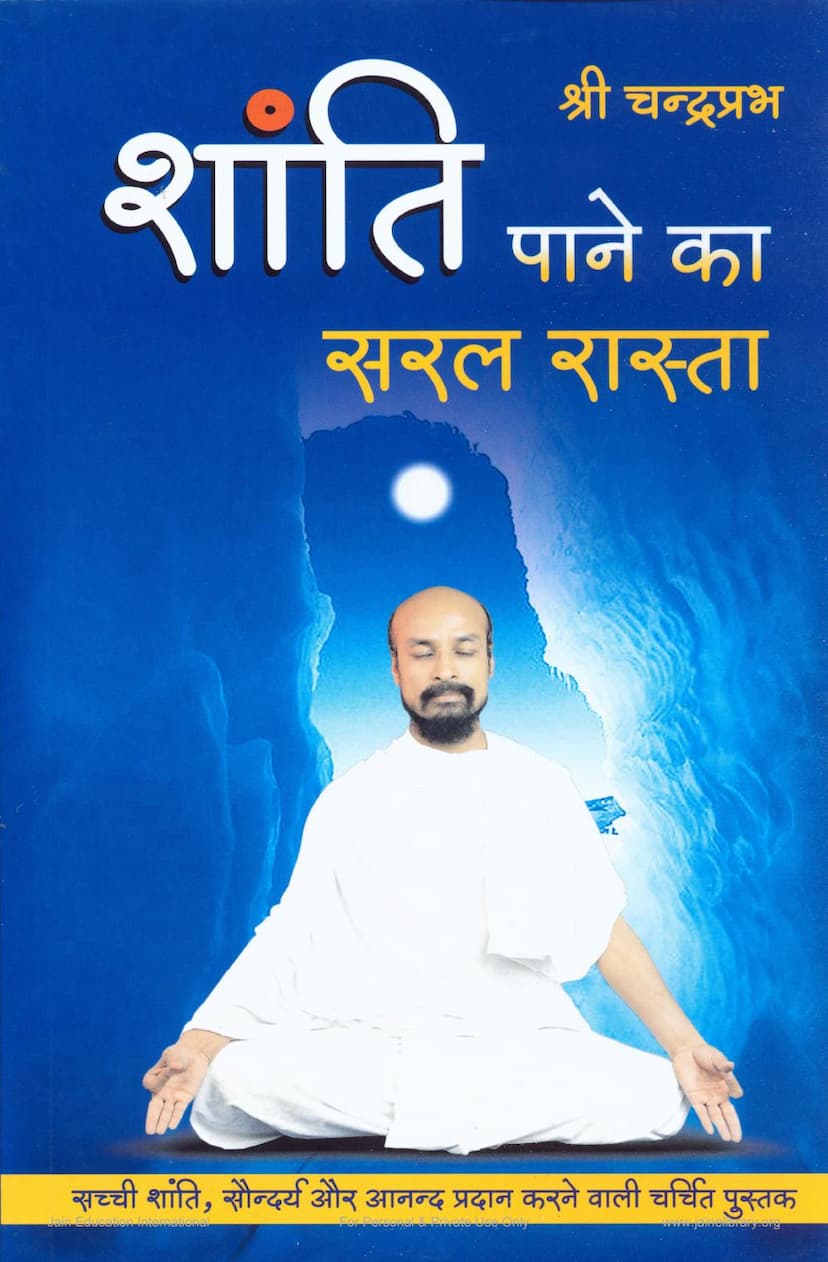Shanti Pane Ka Saral Rasta
Added to library: September 2, 2025

Summary
Here's a comprehensive summary of the Jain text "Shanti Pane ka Saral Rasta" (The Simple Way to Attain Peace) by Shri Chandraprabhsagar, based on the provided pages:
Book Title: Shanti Pane ka Saral Rasta (The Simple Way to Attain Peace) Author: Shri Chandraprabhsagar Publisher: Jityasha Foundation Catalog Link: https://jainqq.org/explore/003959/1
Core Message: The book is a spiritual guide offering practical and simple methods to achieve inner peace, beauty, and joy. It emphasizes that true peace is not just a part of life but a part of the soul. The author, Shri Chandraprabhsagar, presents ancient and new meditation techniques to help individuals connect with their inner self and experience profound happiness.
Key Themes and Concepts:
-
The Choice Between Peace and Success: The book strongly posits that one must choose between pursuing success (often associated with material wealth and worldly achievements) and pursuing peace. The author argues that these two paths are mutually exclusive and cannot be followed simultaneously. Examples of Lord Mahavir and Buddha are given for choosing peace, while figures like Ambani or Amitabh Bachchan are cited for choosing success. The narrative uses a story of a king seeking a person who is both wealthy and peaceful to illustrate this point, highlighting the rarity of such a combination. Ultimately, the reader is urged to decide what truly matters in life.
-
Running the "Peace Channel" in the Mind: A central metaphor is to "run the peace channel" in the mind. This means consciously choosing to focus on peaceful thoughts, feelings, and a positive inner state, much like selecting a favorite channel on a television. The author encourages readers to consistently cultivate a peaceful inner environment.
-
The Power of Inner Peace for Outer Impact: The book emphasizes that an individual who cultivates inner peace can then radiate it to their family, society, and the world. An agitated person will only spread agitation. Becoming peaceful is presented as a profound service to humanity.
-
The Analogy of the Veena's Strings: Life is likened to the strings of a veena. Just as a veena produces beautiful music when its strings are tuned correctly (neither too tight nor too loose), life becomes harmonious and peaceful when one lives with the right balance. This balance is achieved through "Sadhana" (spiritual practice).
-
The Nature of True Joy and Peace: The book argues that true joy and peace are not dependent on external circumstances, possessions, or even the actions of others. They are found within. Examples are given of finding joy in simple things like the blue sky, the morning sun, or a child's laughter. Even in difficult situations, maintaining a positive mindset (positive thinking) is crucial for accessing inner peace.
-
Simplicity and Naturalness (Sahajta): "Sahajta" (naturalness, ease, simplicity) is presented as the first means to happiness, peace, liberation, and ultimately, Samadhi (deep meditation or union with the divine). It means accepting all circumstances, both favorable and unfavorable, as the divine arrangement. Living naturally and authentically is key.
-
Mindfulness and Awareness (Sachetanata): "Sachetanata" (mindfulness, awareness) is highlighted as the path to Bodhi (enlightenment) and liberation. It involves being consciously aware of every action, word, thought, and breath. This practice helps in controlling the mind, reducing negative tendencies like anger, and achieving inner stillness. The story of Shron illustrates the importance of mindfulness versus absent-mindedness.
-
The Importance of Inner Transformation over External Show: The book stresses that true spirituality is not about outward appearances, rituals, or outward displays of devotion. It's about the inner state of mind and heart. The author advocates for living a life of virtue like love, peace, service, and compassion, rather than just following religious dogma.
-
Self-Realization Through Meditation: Meditation is presented as the direct path to knowing oneself – understanding one's true nature beyond relationships, titles, and worldly possessions. By observing the breath and inner states, one can connect with the divine within.
-
Living the "Anandmayi Dharma" (Joyful Religion/Path): The book encourages readers to follow their own true religion or path, which is inherently joyful. It's not about blindly following the teachings of others but discovering one's own inner truth and living in accordance with it. The ultimate goal is to become a "Buddha" or "Mahavir" in one's own right.
-
The Power of a Smile: A smile is described as a simple yet powerful tool for spreading positivity, overcoming negativity, and connecting with others. It's a gift that costs nothing but brings immense benefits. The author encourages readers to "give a smile and receive a smile."
-
Detachment and Non-Attachment (Nirliptata): While living in the world and fulfilling one's duties, it's crucial to remain detached from the outcomes and the world's illusions. This detachment, like a lotus blooming in mud without being stained, is essential for inner peace and liberation.
Structure of the Book (as indicated by the table of contents):
- Decision: Do You Want Peace or Success? (Discusses the choice between material success and inner peace.)
- Run the Peace Channel in the Mind: (Focuses on cultivating a peaceful mental state.)
- Give a Smile, Receive a Smile: (Highlights the power and practice of smiling.)
- Make Naturalness a Means to Samadhi: (Explains the importance of "Sahajta".)
- Peace is Hidden in Mindfulness: (Focuses on the practice of "Sachetanata".)
- Know Yourself Through Meditation: (Explores self-discovery through meditation.)
- Follow the Joyful Religion: (Encourages living according to one's inner, joyful dharma.)
Overall Tone: The book is written in a compassionate, encouraging, and practical tone. Shri Chandraprabhsagar aims to make spiritual principles accessible and applicable to everyday life, guiding readers towards a life filled with peace, joy, and self-awareness. It is presented as a simple and direct path to achieving lasting inner peace.